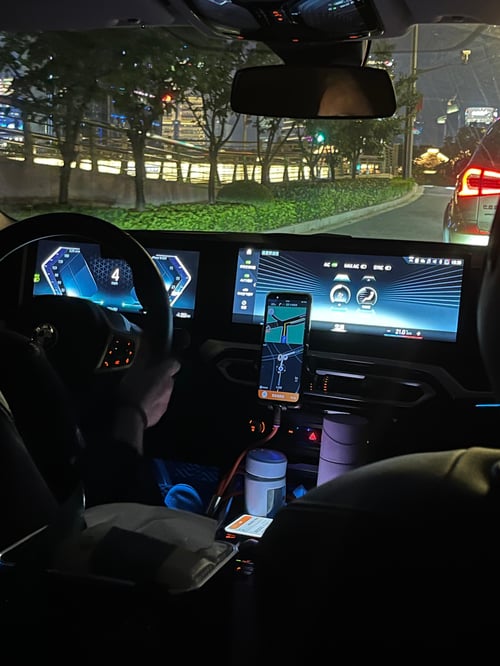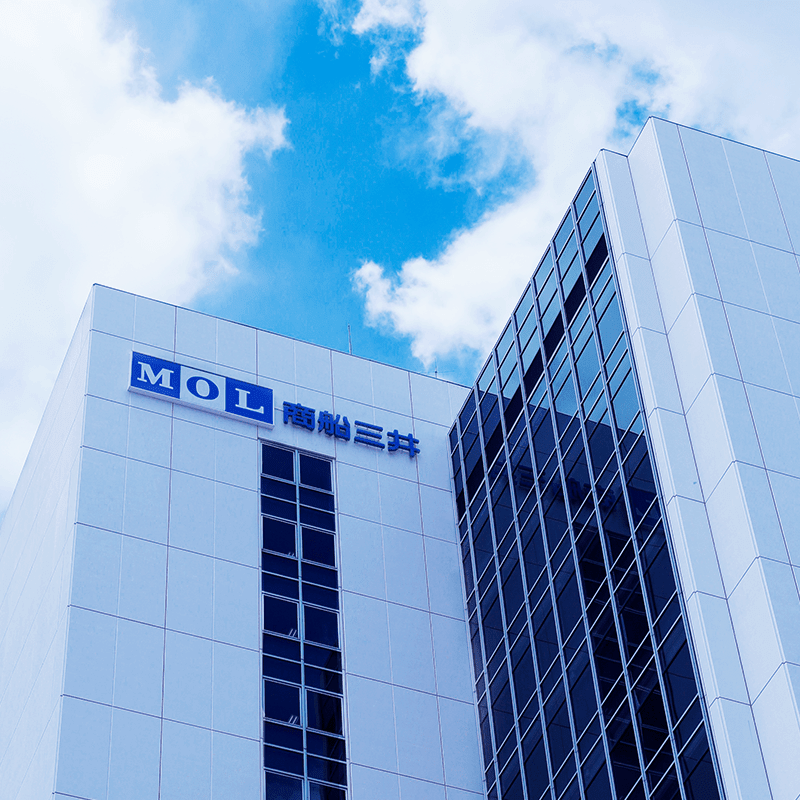BLOG
A New Era of Vehicles in China: The reality of the vehicles situation in China as reported by a local expatriate (Part 1)
- General Shipping
2023.12.19
Greetings from Shanghai, China! This time, we are pleased to bring you firsthand insights into the Chinese vehicle market from our local expatriate.
We, the MOL Auto Carrier Express (MOLACE) of Mitsui O.S.K. Lines, transport a wide variety of vehicles and cargoes, including not only cars but also trucks, buses, and construction machinery, safely and swiftly for our customers on various routes worldwide. Among these, China has been positioned as one of the rapidly growing export destinations in recent years. Despite a number of challenging circumstances, such as lockdowns during the COVID-19 pandemic, China has been able to overcome these hurdles and become a major exporter of New Energy Vehicles (NEVs)*1. We will share with you our observations about China's vehicle market in two parts. In this, the first part, we would like to give a brief overview of the vehicle situation in China.
(*1)New Energy Vehicles (NEVs) in China refer to Plug-in Hybrid Electric Vehicles (PHEVs), Battery Electric Vehicles (BEVs), and Fuel Cell Electric Vehicles (FCEVs).
How many vehicles are in China?
As of the end of June 2023, it is estimated that there are 420 million vehicles (including trucks) in China.
Until 2020, the United States has held the top spot in terms of the number of vehicles, but China has now surpassed it and stands as the world’s leader in the number of vehicles.
For comparison, the number of vehicles in Japan is approximately 80 million as of the end of May, so the number of vehicles per person is higher in Japan, but the overall number gives you a good sense of the scale of the vehicle market in China.
The graph below shows the sales volume (the number of units sold) of vehicles produced in China.

(Source: Marklines)
Although the number of units sold have not returned to the pre-COVID-19 2018 level, the graph shows that over 20 million vehicles are sold each year, even excluding exports (which are included in China's production and sales statistics and amount to about 2-3 million vehicles). For comparison, the annual sales volume in Japan is about 4 million.
What kind of vehicles are being sold?
The sales volume by automakers in 2022 is as follows.

(according to MOL research, including joint ventures and export units,
in 10,000 units)
In China, the manufacturers are referred to in various ways, but the three major automakers are SAIC, FAW, and DONGFENG. Along with CHANGAN and CHERY, they have been collectively known as the "Big Five" automakers. SAIC, ranked first, has maintained the top spot in sales for over 15 years, and FAW and DONGFENG have not given up their second and third place positions for at least the past few years.
However, the rankings, scale, and lineup of automakers other than these top three have been changing dramatically over recent years. GAC, ranked fourth, is been increasing its unit sales through joint ventures with TOYOTA and HONDA and its own NEV brand “AION”. Also, BYD, ranked sixth, was outside the top ten in units sold before 2021, but in 2022, its sales more than doubled from the previous year, rapidly expanding its share not only in China but also overseas.
Overall, it seems that while traditional large-scale automakers continue to maintain their positions, others are gradually making their presence felt and slowly taking market share, creating a situation where many are now vying for dominance.
The following represents the units sold by brand in 2022*2~4..

(Source: Marklines)
*2 VW & Audi includes the units sold as joint venture brands with FAW and SAIC.
*3 TOYOTA includes the units sold as joint venture brands with FAD and GAC.
*4 HONDA includes the units sold as joint venture brands with GAC and DONGFENG.
VW & Audi are in first place, indicating their strong sales base in China, which they have kept since the 1980s. The major difference from last year is that BYD is now the runner-up. Brands such as SAIC, GAC, and FAW are ranked slightly lower than the group sales figures shown in the previous table, because the units sold for joint venture brands with VW, TOYOTA, and HONDA as mentioned in Notes 2-4, are separated.
As can be seen, Chinese automakers vary in their focus, with some primarily concentrating on their own brands (such as BYD and CHANGAN), while others having a significant proportion of joint ventures (such as SAIC and FAW). This is quite different from the situation in Japan.
In China, non-automakers such as Alibaba and Baidu often become joint venture partners. Although their sales scale is not yet large, each manufacturer is working on the production of vehicles specialized in the use of new energy and connectivity (vehicles that are always connected to the internet, have terminal functions, constant vehicle monitoring, and autonomous driving capabilities) through such joint venture companies. While similar initiatives are gradually emerging in Japan, China's initiatives are very quick and dynamic.
Trivia about vehicles in China
Having now talked about sales statistics, we will now leave this topic behind and look at some trivia related to vehicles in China.
Just like anywhere else, a driving license is required in China. Generally, anyone over the age of 18 goes to a driving school (although some people choose not to do so to save money), takes a test, and obtains a license to drive. China uses left-hand drive vehicles and drive on the right side of the road, which is the opposite to Japan.
Having now obtained a license, the next step is to get a car. As mentioned before, there is a wide variety of car options in China. I cannot claim to know them all, and I am sure there are automakers out there that I'm not aware of. The "Hongguang MINI EV" by SAIC-GM-Wuling Automobile, a joint venture between SAIC, GM, and Wuling, has maintained its position as the top-selling car in China for over two years. Its price at launch was incredibly low, equivalent to around 500,000 yen. Conversely, the top-of-the-line sedan model "Hongqi L5" by FAW ranges in price from about 80 million to 100 million yen, clearly demonstrating the wide range of prices even within domestic brands. If you are interested, you can check out the Autohome website (汽车之家in Chinese), which offers price information on all the cars you can buy in China.
Next thing you need when you get a car is a license plate.
.png?width=350&height=119&name=IMG_3172%20(%E5%8A%A0%E5%B7%A5%E6%B8%88).png)
.jpg?width=350&height=178&name=IMG_3176%20(%E5%8A%A0%E5%B7%A5%E6%B8%88).jpg)
(Photo by the author)
The first Chinese character plus alphabet letter on the license plate indicates the registration location. Particularly, the first character represents a nickname for each city.
|
Major cities and provinces |
License plate |
Meaning |
|
Shanghai City |
沪(滬) |
Downstream of the Suzhou River, which flows northeast of Shanghai City, or the name of fishing gear. |
|
Guangdong Province |
粤(越) |
Name of a country formerly in Zhejiang to northern Vietnam. |
|
Beijing City |
京 |
The capital. |
|
Tianjin City |
津 |
The character "津" in Tianjin comes from an old story where an emperor (“天子” in Chinese) of the Yan state passed through the city. |
|
Chongqing City |
渝 |
From the ancient name of the Jialing River in Chongqing. |
|
Henan Province |
豫 (予) |
The name Yo state (“豫州” in chinese) which came from the old days, but there is also a theory that it is related to the fact there were elephants in ancient times. |
|
Yunnan Province |
云 (雲) |
It lies south of the mountain range between Yunling and Sichuan |
(According to the author, there are various theories.)
Each city and province has a one-character nickname, which often has various origins such as ancient place names or rivers that flow through the area. A further investigation into these origins may be interesting.
The green plates in the photo are given to BEVs (Battery Electric Vehicles), which come with various benefits such as reduced acquisition costs. On the other hand, non-BEVs currently receive blue plates (mentioned later). Blue license plates, in addition to the registration location, have five digits or letters. For NEVs (New Energy Vehicles), an alphabet letter always precedes the five digits. If the letters A to D are included, it indicates a BEV; otherwise, it's a non-BEV.
In Shanghai, obtaining a traditional blue license plate required winning a lottery and making a substantial payment (hundreds of thousands of yen!!), while green plates could be obtained easily and for free. This policy aimed to curb the rapid increase in the number of cars and reduce air pollution. When I ask locals about air pollution, they unanimously say that it has significantly improved compared to five years ago (though the Covid-19 pandemic might have played a part in this). In this regard, the policy seems to have been somewhat effective. However, as of January 2023, PHEVs (Plug-in Hybrid Electric Vehicles) are no longer eligible for green plates, and only BEVs (Battery Electric Vehicles) qualify. The reduction in preferential policies for car purchases at the same time is likely having a certain impact on domestic sales.
Just for reference, there are currently a large number of green plates for non-BEVs running in China, as plates obtained before 2022 for PHEVs are still valid.
Others:
① Taxi in China

You’re in luck if you happen to catch a Tesla as a Taxi.

I've only experienced having a BMW Taxi once before. It was a great experience to enjoy a luxury car for a few hundred yen.
② Multiple license plates
.jpg?width=350&height=196&name=%E8%A4%87%E6%95%B0%E3%83%8A%E3%83%B3%E3%83%90%E3%83%BC%E3%83%97%E3%83%AC%E3%83%BC%E3%83%88%20(%E5%8A%A0%E5%B7%A5%E6%B8%88).jpg)
(Photo by the author)
In order to drive from mainland China to Hong Kong or Macau (and vice versa), you need to have license plates for both places. The photo above shows a car with both a yellow license plate for Hong Kong and a domestic number plate for the contiguous Guangdong Province. In the case of Macau, the license plate would be black.
I have never seen it myself, but apparently there are also "triple license plates" that allow entry into Hong Kong, Macau, and mainland China.
③ Motorcycles
While it is a bit off the topic of cars, in China electric motorcycles have become a mainstream transportation means, and you can buy one from around 50,000 yen at a store. Especially in Shanghai, almost no non-electric motorcycles are allowed due to concerns about environmental noise, and gasoline-powered motorcycles (referred to as "bikes") are extremely rare. Bikes are overwhelmingly more expensive than electric motorcycles, the main reason being the cost of the license plate, as with cars. It is said that an “A” number on a license plate, which can be used anywhere in Shanghai, costs from 5 million to 10 million yen, and being able to ride such a bike is considered a kind of status symbol (bike’s license plates will not be obtainable in the future, only existing ones will be auctioned off).
I only hear the sound of a bike exhaust about once a month, and when I see one, I think, "That person must be rich."
.jpg?width=500&height=667&name=IMG_3825%20(%E5%8A%A0%E5%B7%A5%E6%B8%88).jpg)
(The blue number on the right is for an electric motorcycle, and the yellow number in the middle is for a bike. Since it's an “A”, it's top-class.)
In this first part I've briefly introduced the current state of vehicle units sold in China and some trivia about vehicles and motorcycles. In the next part I will share you information about vehicle exports from China and future prospects.
Look forward to seeing you in part 2!

A New Era of Vehicles in China:~Rapid change in China's Automobile Export Business (Part 2)~

Writer:Shunichiro. F
I’ve joined MOL in 2015 after working for a bank. After spending 4 years in the legal division, now I’m involved in MOLACE and in charge of sales for Asia and Oceania. In July 2022, I landed in Shanghai, China after the lockdown ended, where I am now struggling every day with the rapidly changing situation in China. I love traveling, and the photo is when I dived into Milky Way, a natural mud pack cove in Palau.
Recommended Articles
2022.07.05
- General Shipping
2021.04.13
- Energy
2023.12.19
- General Shipping
2021.08.07
- Eco Friendly
2024.02.06
- General Shipping
- Market Analysis
Latest Articles
2025.11.20
- Energy
- General Shipping
2025.11.11
- General Shipping
2025.10.28
- Energy
- Eco Friendly
- General Shipping
- BLOG
- A New Era of Vehicles in China: The reality of the vehicles situation in China as reported by a local expatriate (Part 1)








